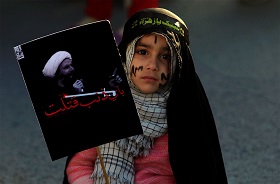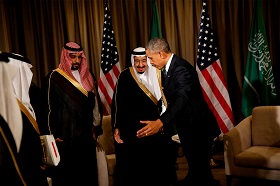The crisis that erupted between Saudi Arabia and Iran recently has been brewing for years now. There is no arguing that the two countries have never been allies but since the start of the armed conflict in Syria they found themselves directly challenging each other’s interests. The diplomatic tension intensified even further when Saudi Arabia launched its Yemeni military campaign against the Houthis who enjoy wide support of Tehran.
The crisis that erupted between Saudi Arabia and Iran recently has been brewing for years now. There is no arguing that the two countries have never been allies but since the start of the armed conflict in Syria they found themselves directly challenging each other’s interests. The diplomatic tension intensified even further when Saudi Arabia launched its Yemeni military campaign against the Houthis who enjoy wide support of Tehran.
Riyadh’s decision to execute Shia cleric Sheikh Nimr Al Nimr among 47 convicts (including recognized Al Qaeda members) was a particularly threatening message to Iran in which Shia clerics are recognized as terrorists. There is little doubt among experts and commentators that the execution was a carefully planned political decision designed to provoke Iran into careless actions. The attack on the Saudi embassy (that was evacuated beforehand) was expected but it was significantly less brutal than Riyadh may have anticipated. The Iranian leadership was perfectly aware that it was in the spotlight due to the nuclear deal whose implementation should have been confirmed days after the execution and didn’t want to make headlines for all the wrong reasons. In fact there are suspicions that Tehran may have approved a protest in front of the Saudi embassy but not its siege.
Riyadh’s decision to suspend its diplomatic ties and trade was largely a symbolic gesture because there is not much of either in their bilateral relations. Saudi Arabia was likely betting on Tehran’s more bitter and aggressive reaction such as publicly rallying support of Saudi Shia or even shutting the Straight of Hormuz which would have had negative consequences for all of the GCC.
The reasons why the Saudi leadership makes risky moves in its Iran policy are multifaceted. Riyadh openly opposes the nuclear deal that was reached between Iran and the six world powers in July last year. It fears that the lifting of anti-Iran economic sanctions will make Tehran significantly stronger both financially and politically which will increase its regional standing.
Observers couldn’t help but notice mounting discord in US-Saudi relations since the nuclear deal was singed last year. Some Saudi officials openly say that they were left on their own by the United States and are disappointed in President Obama. Washington’s muted reaction to the Iran-Saudi diplomatic conflict is an indication that the White House does not necessarily agree with Saudi Arabia on the execution and that it doesn’t want to continue to antagonize Iran. It is too early, however, to speculate whether Washington is ready to improve relations with Tehran but it is certainly willing to reach out to the Iranian leadership. It would be in Saudi Arabia’s interest to prevent the US from getting closer to Iran, hence the orchestrated diplomatic crisis may have aimed at “exposing Tehran’s true nature.”
On the domestic front, infighting within the leadership could also explain why Saudi Arabia decided to sever ties with Tehran. King Salman who ascended to the throne in January 2015 has been looking to produce a major shake-up in the Saudi monarchy. First, he removed his half-brother Muqrin from his position as Crown Prince and may now be looking to change the entire logic of succession in the country, from lateral or diagonal order to a vertical one so that his son and current Defense Minister Mohammad would become the next King. The competition between Crown Prince Muhammad bin Nayef (Minister of the Interior) and Deputy Crown Prince Mohammad bin Salman (Defense Minister) has intensified recently. It is alleged that attempts are being made to marginalize the Crown Prince by arguing that only a strong and young king, current Minister of Defense, is fit to deal with ongoing crises around Saudi Arabia, including the war in Yemen and insurgent Iran.
For Tehran the diplomatic crisis also came at a difficult time. Understanding the dire consequences of engaging in a diplomatic spat with Saudi Arabia the Iranian leadership acted with restraint despite the embassy siege. Domestically, the leadership feels immense pressure due to upcoming Parliamentary and Assembly of Experts elections in February. The Assembly that is elected once in 8 years is the only body with the authority to dismiss and appoint the Supreme Leader. Given that Ayatollah Khemenei is 77 years old it is extremely important for the centrist President Rouhani to remain in control of the Assembly for the next eight years.
For Iran, the conflict with Saudi Arabia was coming on the eve of the so-called implementation day, when the UN was expected to confirm Iran’s compliance with the nuclear deal, eventually leading to the withdrawal of sanctions against Tehran. For President Rouhani it was crucial to present the day the sanctions get lifted as his victory to the public at home, while the diplomatic dispute could easily overshadow his triumph. Tehran wisely chose not to escalate the crisis further given the high costs it could bear, including derailing the nuclear deal confirmation.
Now that sanctions against Tehran have been lifted we are about to see Saudi Arabia and Iran swap their roles: Riyadh will now have to learn to live under financial constraints and cut its lavish social benefits for citizens. Meanwhile Iran is preparing for a massive inflow of western investment and looks to expand its economic activity. Saudi Arabia risks to lose its position of the player who defines the global oil price. This role may now pass on to Iran whose decision as to how much oil it will produce and sell internationally will determine trends in the market. Iran by default finds itself in a better economic position now because even a mere $25 per barrel is a boon to its economy.
Since the armed conflict in Syria is viewed by many experts as a proxy war between Iran and Saudi Arabia there are high risks of the Syrian diplomatic process getting stalled. It is especially alarming given the fact that world powers have set very optimistic goals for the next eighteen months that should eventually lead to presidential elections in Syria. While both countries say that their dispute won’t affect Syria talks, there is a number of Saudi-backed opposition groups, such as Jaish Al Islam, who cast doubt on the UN-led peace process.
The Iran-supported Syrian government has already confirmed its participation in peace talks that will take place in Geneva on January 25. Opposition groups, however, have not done so yet. And this is exactly what should concern Riyadh, because if these groups don’t show up in Geneva Iran will have a good reason to blame Saudi Arabia for derailing Syria talks over their own dispute.
All in all, it seems that diplomatically Saudi Arabia has fallen into its own trap. The Iranian leadership quickly realized the risks of the conflict’s escalation and chose to act with restraint following the embassy’s siege. Riyadh’s long-time ally the United States decided not to take sides in the conflict, while other GCC members only formally sided with their neighbor exposing the limitations of Saudi influence in the region.






